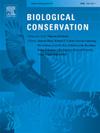From isolation to connectivity: A graph theory approach for optimising karst protected areas using an umbrella species
IF 4.4
1区 环境科学与生态学
Q1 BIODIVERSITY CONSERVATION
引用次数: 0
Abstract
Karst Forest is a unique ecosystem hosting high levels of both biodiversity and endemism. However, karst ecosystems are threatened, both by forest loss and degradation. Developing frameworks to more effectively conserve karst ecosystems are essential to conserve these fragile ecosystems. The White-headed langur is an endangered primate restricted to karst forest, and provides a case-study of conservation of range-limited species and ecosystems. We analyzed the connectivity of natural forest patches based on white-headed langur's dispersal probabilities over different distances and resistance values estimated from habitat model. We then simulated the scenarios of transforming plantation and farmland to natural forest at different distances and identified the optimal restoration scale of langur's habitat with the enhancement of connectivity under different scenarios. In total 298 forest patches of 590 km2 are the top 10 % of contributors to landscape connectivity across all dispersal distances, of which 53 (351 km2) are within nature reserves, and 11 of which are occupied by langurs. Simulation of restoration scenarios revealed that converting plantation and farmland to natural forest within 600-m buffer zones optimally enhanced habitat connectivity., and many small forest patches outside NR could act as OECMs to maintain landscape connectivity We recommend that habitat restoration be first conducted around patches with high density and isolation of langur populations, and all 298 patches should be protected and reconnected if possible. These conservation measures will benefit other karst endemic species, and improve local functional connectivity.
从隔离到连通性:利用保护伞物种优化喀斯特保护区的图论方法
喀斯特森林是一个独特的生态系统,具有高度的生物多样性和地方性。然而,喀斯特生态系统受到森林损失和退化的威胁。制定框架以更有效地保护喀斯特生态系统对于保护这些脆弱的生态系统至关重要。白头叶猴是喀斯特森林中的一种濒危灵长类动物,为保护范围有限的物种和生态系统提供了一个案例研究。基于白头叶猴在不同距离上的扩散概率和生境模型估算的阻力值,分析了天然林斑块的连通性。在此基础上,模拟了人工林和农田向天然林转变的不同距离情景,确定了不同情景下叶猴栖息地随着连通性增强的最佳恢复尺度。在所有分布距离中,总面积为590平方公里的298个森林斑块是景观连通性的前10%贡献者,其中53个(351平方公里)位于自然保护区内,其中11个被叶猴占据。恢复情景模拟结果表明,在600 m缓冲区内,将人工林和农田转化为天然林可最佳地增强栖息地的连通性。建议首先在叶猴种群密度高、种群隔离的叶猴斑块周围进行生境恢复,并在可能的情况下对所有298个叶猴斑块进行保护和重新连接。这些保护措施将使其他喀斯特特有物种受益,并改善当地的功能连通性。
本文章由计算机程序翻译,如有差异,请以英文原文为准。
求助全文
约1分钟内获得全文
求助全文
来源期刊

Biological Conservation
环境科学-环境科学
CiteScore
10.20
自引率
3.40%
发文量
295
审稿时长
61 days
期刊介绍:
Biological Conservation is an international leading journal in the discipline of conservation biology. The journal publishes articles spanning a diverse range of fields that contribute to the biological, sociological, and economic dimensions of conservation and natural resource management. The primary aim of Biological Conservation is the publication of high-quality papers that advance the science and practice of conservation, or which demonstrate the application of conservation principles for natural resource management and policy. Therefore it will be of interest to a broad international readership.
 求助内容:
求助内容: 应助结果提醒方式:
应助结果提醒方式:


